Matsuno’o Taisha|松尾大社
Overview

Located just south of the renowned Arashiyama district, it’s said Matsuno’o Taisha was founded in 701, making it one of the oldest in the area. Bordering up against a mountain, Matsuno’o Taisha’s distinctive main hall has been dated to 1397, and is one of the oldest extant buildings in the city proper that wasn’t lost to fire. The shrine’s spring is famous for its restorative properties and many sake and miso producers patron the shrine, their industries relying on pure water to survive. With a distinctive giant torii gate, three lovely gardens designed by Shigemori Mirei, and a sacred waterfall, this sprawling shrine offers quite a bit to explore. Keep your eyes peeled for turtles, and on your way out you can explore a small sake museum or purchase tsukemono.
With a distinctive giant torii gate, three lovely gardens designed by Shigemori Mirei, and a sacred waterfall, this sprawling shrine offers quite a bit to explore.
Features
Giant Torii & Gate
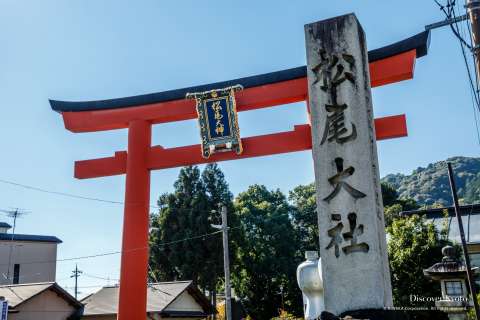
It’s hard to miss Matsuno’o Taisha, considering the size of its large vermilion torii gate, standing at 14 meters tall. Crossing under the large gate and heading down the path brings you to a somewhat uncommon site for a Shinto shrine, a two story rōmon gate that has two zuishin warriors installed on either side of the entrance. Rather than being a bright vermilion structure like you are more likely to see at other shrines, Matsuno’o Taisha’s gate maintains its natural wooden appearance, decorated with donated lanterns.
Shigemori Mirei’s Three Gardens
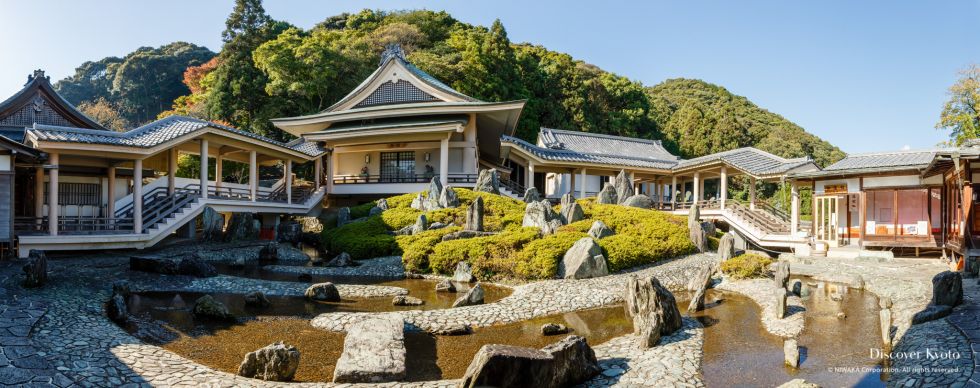
Designed by Shigemori Mirei, one of the most famous modern-traditional garden designers in Kyoto, three gardens were completed for Matsuno’o Taisha in 1975. The Jōkō Garden represents the ancient period of Japanese history with large jagged rocks amidst a landscape designed to appear as a wild mountaintop. The Horai Garden is a Kamakura Period-style depiction of the Chinese concept of paradise, with rocks representing islands in the sea. In the Heian Period-style, the Kyokusui Garden is largely flat with a stream flowing through rocks and azalea bushes. Though the shrine itself is free, visiting the gardens requires a ticket that costs ¥500.
Main Hall

Though hard to see from the outside, this honden (main hall) is constructed in a distinctive style called matsuozukuri, boasting a distinctive roof that flows down and forms a portico in both front and back of the structure. An Important Cultural Asset, records date this structure back to construction in 1397. This is actually quite amazing, as most of the shrines and temples in the old capital suffered damage or were destroyed altogether during the 15th century Ōnin Civil War and other periods of unrest and fire in Kyoto’s history. Though many places in Kyoto have ancient histories, most buildings themselves are not as old as this one.
Turtles, Turtles Everywhere
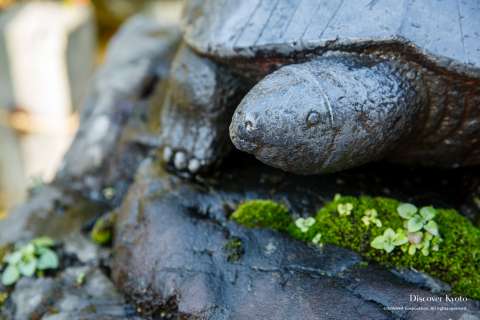
Turtles and tortoises have long had fortuitous meanings in Asian cultures, representing good fortune and long life. Since turtles (and koi fish) are considered the sacred messengers of the mountain god enshrined in the main hall, turtle imagery abounds throughout the Matsuno’o Taisha grounds. Near the entrance to one of the gardens is the Kame no I, the “Tortoise Well”, and those who drink water from this well are said to be blessed with health and longevity. Near the gate is a black turtle placed on a rock called “Nade Kame-san” that is said to good things to those who pet it, and people making prayers are encouraged to also visit the small statues of a turtle and koi on either side of the main hall. Keep your eyes peeled as you walk around, because you never know where you might find a turtle at Matsuno’o Taisha.
Ritual Sake

Since Matsuno’o Taisha is famous for its relation to sake production, brewers from all over Kyoto and even the farthest reaches of the country come to pray at this shrine and receive some of its sacred waters. In return, these brewers donate casks of their product to be used in the shrine’s rituals. While such donations are usual, Matsuno’o Taisha boasts a considerable collection of interesting casks that can be viewed to the left of the haiden stage. For those more interested in sampling the wares, check out this shrine for your new year’s visit and try their kinpaku sake filled with gold leaf, or their blessed miki sake.
Sacred Waterfall
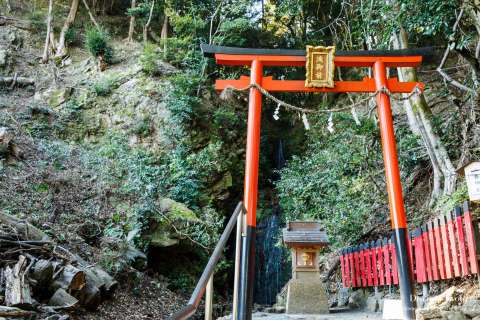
In the far back of the shrine’s precincts is a waterfall that falls from Mt. Matsuo, also known as Wakeikazuchi no Yama. It is this waterfall that features in a legend about the shrine in which a turtle was seen in the water and inspired the nobleman who saw it, leading to the waterfall being called the Reiki no Taki, or “Waterfall of the Mysterious Turtle”. To this day, sake and miso producers come all the way to Matsuno’o Taisha to receive some of this sacred water to use in making their goods.
Shinzōkan Statuary Hall

A small treasure hall of statuary on the Matsuno’o Taisha property can easily be overlooked, but if you have an interest in history be sure to use your garden ticket and check out the 21 statues displayed within. In their midst are three wooden statues believed to be of the gods worshipped at Matsuno’o Taisha: Ōyamagui no Kami, a god of mountains, Ichikishima-hime no Mikoto, a goddess of water travel, and Mikogami. These three statues are actually some of the oldest and best preserved of their kind, dating back a thousand years to the Heian period.
History
One of the oldest shrines in Kyoto, Matsuno’o Taisha was founded in 701 by members of the Hata clan, a Chinese immigrant clan that traveled from Korea to Nara, Japan, until settling in the Kyoto area. The Hata clan were involved in various enterprises, including sake production, and using the proceeds from those ventures founded Matsuno’o Taisha along with another famous shrine, Fushimi Inari Taisha. Having purportedly brought the latest sake brewing techniques from mainland Asia, Matsuno’o Taisha became famous over the years among sake brewers, who still make pilgrimages to the shrine and take water from its sacred well. The Hata clan possessed much in the way of wealth and power in that period, and it’s said that this had some influence on the selection of Kyoto as the site of the new capital.
A legend about Matsuno’o Taisha states that during the transfer of the capital from Nagaoka to Kyoto in 794, a member of the Hata clan saw a turtle bathing under a spring’s waterfall, which was viewed as a favorable omen.
Matsuno’o Taisha enjoyed the patronage of the Imperial family from the Heian Period onwards. In 965, when Emperor Murakami ordered that sixteen important shrines would receive imperial messengers who would pass on news of major events to the kami, Matsuno’o Taisha was selected as one of these heihaku shrines.
During the period of State Shinto from 1871 to 1945, Matsuno’o Taisha was designated as a kanpei-taisha, among the top rank of shrines supported by the government.
Events
January 3rd | Chinese Zodiac Celebration Festival (Eto Shukujū-sai) |
|---|---|
February 3rd |
Setsubun |
February 11th |
Foundation Day Festival (Kigen-sai) |
February 28th | Hina Matsuri |
April | Brewer’s Thanksgiving (Shōzō Kansha-sai, Chūyū-sai) |
April | Annual Festival, Departure of the Portable Shrine (Shinkō-sai) |
April | Yamabuki (Japanese Yellow Rose) Blooming Season |
May | Annual Festival, Return of the Portable Shrine (Kankō-sai) |
June | Rice Planting Ritual (Go Taue-shiki) |
June 28th – 30th | Summer Purification Ritual (Nagoshi no Harae) |
July 7th | Tanabata Star Festival |
July | Field Festival (Onda-sai) |
September | Hassaku Festival |
September | Moon Viewing (Kangetsu-sai) |
November | Brewer’s Day of Supplication (Shōzō Kigan-sai) |
December 31st | Winter Purification Ritual (Ōharae-shiki) |
Access
Address
〒616-0024 西京区嵐山宮町3
| TEL | 075-871-5016 |
| FAX | 075-871-3434 |
| WEB | http://www.matsunoo.or.jp/en/ |
Admission
- General Admission: Free
- Shrine Gardens & Museum: ¥500
Hours
- General Admission: 05:00 - 18:00
- Closed: No closing days
Transportation
Gallery
-

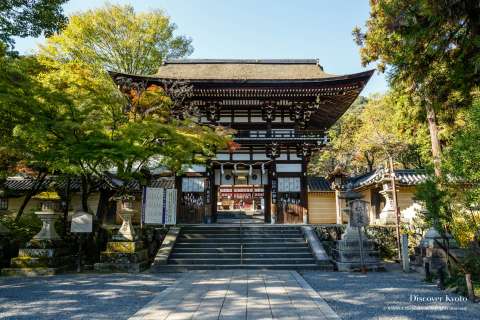
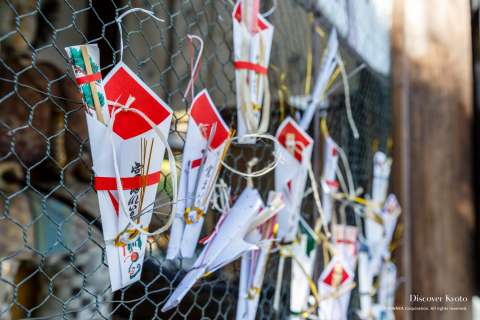

 +28
+28
